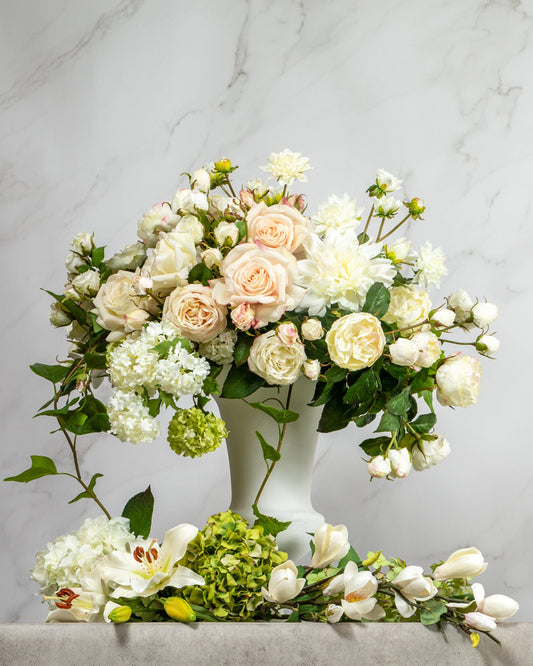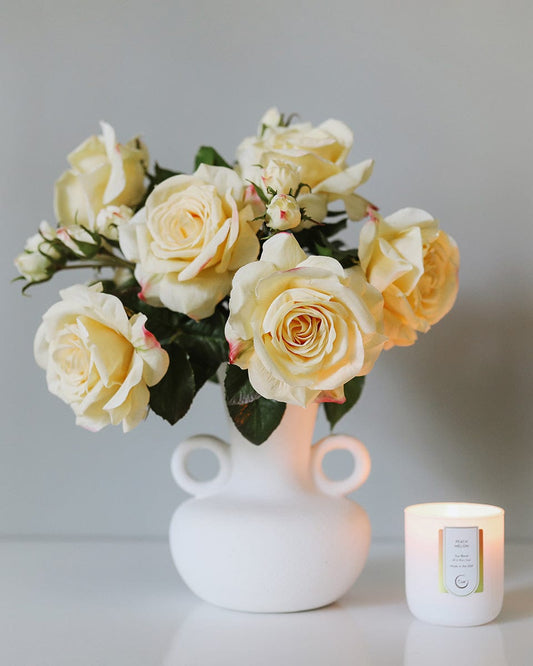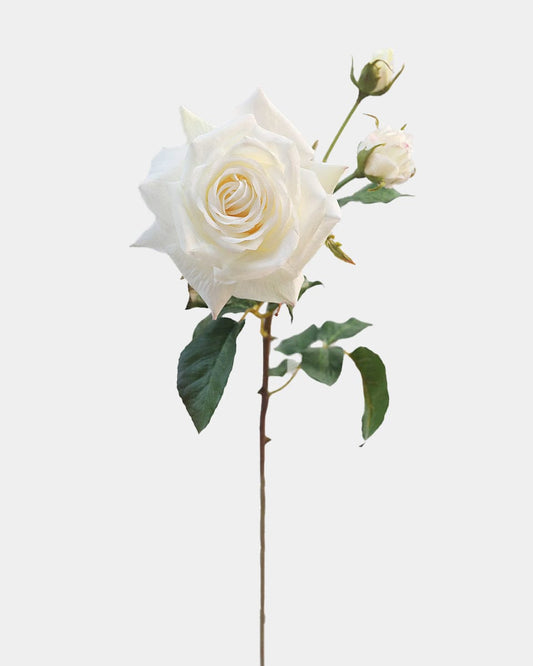Artificial Rose Types: A Guide to Realistic Design

As an artificial rose specialist who has spent nearly two decades studying and recreating nature's most beloved flower, I've developed a deep appreciation for how different rose classifications translate into the world of permanent botanicals. Creating lifelike artificial roses isn't simply about making something that looks pretty—it's about honoring the distinct character and heritage of each rose variety through meticulous design techniques.
Key Takeaways
- Different rose classifications require specific design approaches to capture their unique characteristics
- Color gradation techniques are essential for recreating the subtle hue variations found in natural roses
- Petal count and arrangement must be precisely calibrated to each rose variety's botanical structure
- Stem flexibility and foliage accuracy significantly contribute to an artificial rose's authentic appearance
- Modern materials allow for unprecedented realism in capturing the distinct textures of various rose families
Understanding Rose Classifications Through Artificial Design
When I first began specializing in artificial roses, I quickly realized that a one-size-fits-all approach wouldn't suffice. Each rose family—from Hybrid Teas to Old Garden Roses—possesses distinctive traits that demand specialized techniques to recreate authentically.
The world of roses is wonderfully diverse, with classifications that span centuries of cultivation. What fascinates me most is how these classifications manifest in structural differences that we must carefully consider in artificial design. A Floribunda rose, for instance, with its clustered blooming habit, requires a completely different approach than the dramatic, high-centered form of a Hybrid Tea.
I remember working on a special commission for a historical property that wanted to showcase extinct Gallica roses. I spent weeks studying botanical illustrations from the 16th century, noting the distinctive quartered form and petal recursion patterns that defined these ancient varieties. The final artificial recreations captured not just the appearance but the very essence of these historical treasures—something that would have been impossible without understanding the classification's unique characteristics.
Capturing Hybrid Tea Elegance in Artificial Form
Hybrid Tea roses, with their classic high-centered buds and elegant, spiral-opening blooms, present a fascinating challenge in artificial design. These modern roses, which emerged in the late 19th century, are characterized by their perfect form and often feature 30-35 petals arranged in a distinctive spiral pattern. For an in-depth exploration of how petal counts define rose authenticity across different varieties, including specific mathematical patterns for each classification.
When creating artificial Hybrid Teas, I pay particular attention to what I call the "bloom profile"—the iconic pointed bud that gradually unfurls into a symmetrical bloom. This requires precise petal layering techniques and careful attention to the interfacial tension between petals.
Our Real Touch Prestige Red Rose exemplifies the Hybrid Tea structure perfectly. I've developed a specialized multi-layered coloration technique for these roses that creates the depth characteristic of classic red Hybrid Teas. The color isn't a flat red—it's a complex interplay of deep crimson that intensifies toward the center, just as you'd see in natural specimens.
"The challenge with Hybrid Teas," I often tell my workshop participants, "isn't just getting the form right—it's capturing that sense of potential movement, that feeling that the bloom is still actively unfurling even though it's perfectly still."
The Romantic Complexity of Old Garden Roses
Old Garden Roses—those classified as existing before 1867—possess a romantic, often quartered form that differs dramatically from modern varieties. These historical roses, including Alba, Gallica, Damask, and Centifolia types, present unique challenges in artificial reproduction.
The Centifolia or "Cabbage Rose," for example, features densely packed petals that create a distinctive domed shape. When crafting artificial versions, I use what I call "petal recursion mapping"—carefully plotting how each layer of petals folds and turns to create that characteristic cabbage-like appearance.
Our Pink Prestige Rose incorporates elements inspired by Old Garden Roses, particularly in its open-faced design and gently reflexed outer petals. The soft pink coloration required a specialized air-infused dyeing technique to achieve the subtle color variations that characterize many antique rose varieties.
I've found that capturing the essence of Old Garden Roses isn't just about visual accuracy—it's about conveying a sense of historical authenticity. These roses tell stories of centuries past, and their artificial counterparts should evoke that same connection to heritage and tradition.
Floribunda and Cluster-Flowering Varieties in Artificial Form
Floribunda roses, with their abundant clusters of smaller blooms, present an entirely different set of design considerations. These varieties, which resulted from crossing Hybrid Teas with Polyantha roses, are characterized by their prolific flowering and often feature 15-25 petals per bloom in tight clusters.
When designing artificial Floribundas, I focus on what I call "bloom staging"—creating multiple flowers at different opening stages on a single stem. This requires careful attention to botanical proportion and internodal spacing to achieve a natural appearance.
Our Real Touch Pink Rose exemplifies the Floribunda style beautifully. I specifically designed this piece to capture the charming cluster effect of these garden favorites. The challenge was creating the natural variation between blooms—no two flowers in a Floribunda cluster are identical, and our artificial version needed to reflect that authentic diversity.
"Floribundas are all about abundance," I often say. "When recreating them, we need to embrace their joyful profusion while maintaining botanical accuracy in how the clusters form and present themselves." These prolific bloomers make perfect choices for creating abundant National Rose Month displays with year-round impact.
Color Authenticity Across Rose Classifications
Color is perhaps the most immediately noticeable aspect of any rose, but achieving authentic coloration in artificial roses requires understanding how different classifications express color differently. Tea Roses, for example, often feature subtle color shifts from petal base to edge, while many modern varieties display more uniform coloration.
I've developed specialized techniques for each rose family. For varieties like the sunset-hued roses popular in English gardens, I use a process I call "pigment stratification"—layering different colored pigments to create depth and dimension that mimics natural color variations.
Our Sunset Rose showcases this technique beautifully. The warm gradient from orange to pink required developing a special double-infusion process that allows colors to blend naturally, just as they would in garden varieties with this coloration. I'm particularly proud of how we've captured the subtle translucency at the petal edges—a characteristic feature of many sunset-toned roses.
One of my favorite projects involved recreating a collection of historically significant roses for a museum exhibition. The challenge was reproducing the exact coloration of varieties that hadn't been grown for centuries, using only paintings and written descriptions as references. Through careful research and color matching, we were able to bring these lost varieties back to life in permanent form.
Translating Classic White Roses Across Varieties
White roses hold special significance in many cultures and appear across virtually all rose classifications. However, not all white roses are created equal—each classification expresses "whiteness" differently, from the creamy ivory of many Tea Roses to the pure snow-white of certain Hybrid Teas.
When designing artificial white roses, I pay particular attention to what I call "photometric response"—how the material interacts with light. Natural white roses have a distinctive luminosity that comes from light penetrating and reflecting through the petals, and capturing this quality requires specialized materials.
Our Real Touch White Rose exemplifies this approach. I developed a translucent edge technique specifically for our white roses that creates that characteristic glow when light passes through the petals. The challenge was finding the perfect balance—too translucent and the rose looks artificial, not translucent enough and it loses that ethereal quality unique to white roses.
I once worked with a bride who wanted to recreate her grandmother's wedding bouquet of Alba roses—ancient white varieties known for their distinctive gray-green foliage and subtle ivory tint. We spent weeks perfecting the exact shade of white with just a hint of cream at the base of the petals, characteristic of this particular classification. The result brought tears to her eyes when she saw how accurately we'd captured the essence of these historical blooms.
The Future of Artificial Rose Design
As materials science continues to advance, the possibilities for artificial rose design grow increasingly sophisticated. I'm particularly excited about new developments in variable-density fabrics that allow for even more accurate recreation of petal structures across different rose classifications.
The most promising innovations combine botanical accuracy with practical advantages. New UV-resistant pigments, for example, allow us to create artificial roses that maintain their color fidelity for years, even in direct sunlight—something particularly important for outdoor installations or sunroom displays.
I believe the future of artificial rose design lies in even greater variety-specific accuracy. Rather than generic "roses," we're moving toward collections that faithfully represent specific cultivars with all their unique characteristics. This represents a more sophisticated approach that honors the rich diversity of the rose world.
The art of artificial rose design continues to evolve, but its foundation remains the same: a deep respect for the unique characteristics that define each rose classification. Explore our complete collection of botanically accurate artificial roses featuring authentic reproductions of classic and modern varieties.
🌹 The Beauty That Never Fades
Our faux roses capture the very essence of nature. Come and explore our best selling collection!
Shop Artificial Roses Now



















